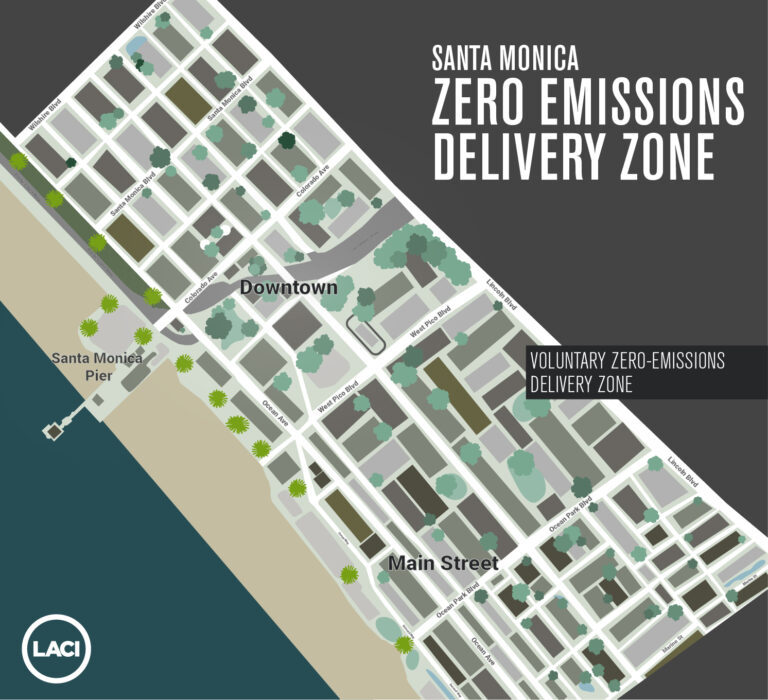
Santa Monica’s Zero-Emissions Delivery Zone Pilot is now underway, and program participants are hoping a successful test run in the city will result in similar initiatives throughout the Westside in the near future.
Thanks to a partnership between the City, Los Angeles Cleantech Incubator and a number of private companies, the first-in-the-nation Zero Emissions Delivery Zone stretches from the city’s southern border at Dewey Street to Wilshire Boulevard, and from the ocean eastward to Lincoln Boulevard.
Residents in the area may have already spotted robots delivering sandwiches or electric bicycles carting small packages since the pilot first kicked off last year when local companies, like Cyan Robotics and its handful of human-powered bots, eagerly signed on to deliver goods from restaurants like Alfalfa on Main Street. And earlier this month, Santa Monica City Council approved a license agreement that grants computer software company Automotus the ability to mount video camera equipment on City street lights in the pilot zone.
The data collected will help ensure delivery vehicles in the zone are compliant with the zero emissions regulations, staff said in a report, and also serve as a real-time monitor of the dwell time for vehicles, what curb space is available, how congested streets are.
LACI CEO Matt Petersen said at the beginning of the pilot that data like this was key to the program’s success because it allows program leaders to assess the pilot’s impact on delivery efficiency, safety, congestion, and emissions, and also gives staff the ability to evaluate operations within the zone so it can return to Council with a long-term strategy in the future.
“We have a working group that’s focused on goods movement and primarily looks at those heavy-duty trucks that come in and out of the ports of Los Angeles and Long Beach before they head to our freeways to move goods from warehouses and beyond,” Petersen said. “But once those vehicles reach their destinations and the goods get on medium-duty trucks, we’re trying to find ways to reduce emissions in the neighborhood and throughout that process — that’s what we want to learn.”
Petersen detailed how large trucks delivering small packages cause increased congestion and pollution on smaller streets while also blocking bike lanes and vital parking spaces. But the pilot program looks to curb these problems and others by eventually ridding the area of any gas-guzzling delivery vehicles that bring goods to customers in city centers, and eventually residential areas.
“Other forms of transportation we’re looking at is package delivery to homes and businesses, which would be in those medium duty trucks,” Petersen added. “And we’re also looking at food delivery, which currently is primarily delivered by single passenger vehicles, but I think there are a lot of other forms of modalities that could be used — perhaps a cargo bike.”
Petersen and his fellow program participants hope Santa Monica’s success will serve as a blueprint to a zero emissions delivery zone that could be adopted by other cities in the Southern California region by 2028, he said as he detailed how Santa Monica’s unique infrastructure made it the perfect place to test the idea.
“We had to pick one community to start with, and since Santa Monica was in front of the fray in terms of micromobility — that’s something that stood out. And it’s also a place where you’ve got that unique mix of residential and commercial density segments,” Petersen said. “So even though Santa Monica will be at the center of the work, it’s a project that everyone is going to learn from.”
Mayor Sue Himmelrich agreed.
“To reduce and ultimately eliminate our carbon emissions, we need to look at all aspects of the transportation sector. This pilot with LACI will use smaller and cleaner technologies to deliver goods instead of the large diesel-fueled trucks we’re used to seeing on our streets. Beyond reducing carbon and congestion, the added bonus is that restaurants can keep higher margins of sales on delivered food items,” she said. “This is coming at a critical moment in our recovery and we look forward to new insights on zero-emissions delivery and the possibilities beyond our one square mile test zone.”
Brennon@smdp.com









